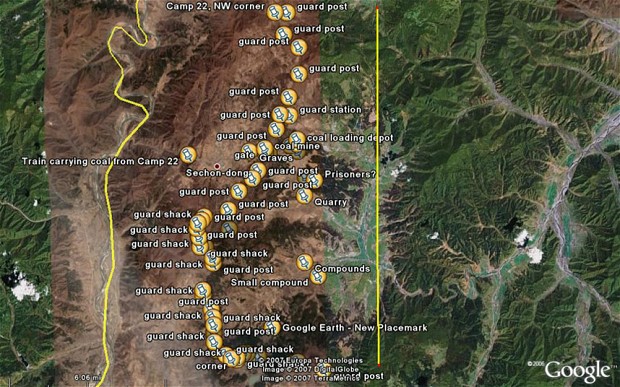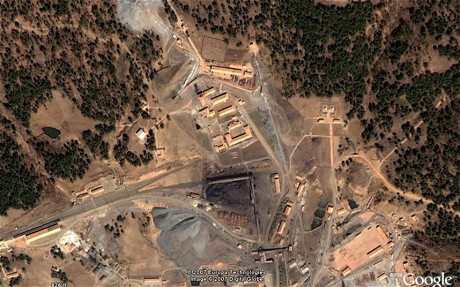Human rights activists are turning to Google Earth to identify the vast network of prison camps that dot the North Korean countryside and hold as many as 200,000 people deemed hostile to the regime.

A number of structures have been identifed at camp 22. These include guard houses and burial grounds
– Google Earth exposes North Korea’s secret prison camps (Telegraph, Jan 25, 2013):
Rights groups are pushing the United Nations high commissioner for human rights to open an international investigation into Pyongyang’s “deplorable” record on its citizens’ rights, including a system of political prisons that has operated for more than 50 years.
Pyongyang insists that the camps do not exist and are merely foreign propaganda, but the advent of high-resolution, free images from outer space has disproved that claim.
On January 18, the North Korean Economy Watch website announced that a new camp had been identified alongside an existing detention facility in Kaechon, South Pyongan Province.
Using newly provided Google Earth images, analyst Curtis Melvin was able to conclude that the new camp sits alongside Camp 14 and has a perimeter fence that stretches nearly 13 miles.
The facility was built since the last images of the site were released, in December 2006.
The fence has two checkpoints and six guard posts, while a number of accommodation units and office buildings are also clearly visible. A coal mine within the fence does not appear to be operational, Melvin concluded.
Very few North Koreans have managed to escape from prison camps and to freedom outside the country’s borders, but those who have tell of terrible suffering.
Inmates – who can be imprisoned for life, along with three generations of their families, for anything deemed to be critical of the regime – are forced to survive by eating rats and picking corn kernels out of animal waste.

Google view of Camp 22 Credit: Google/One Free Korea
Activists say that as many as 40 per cent of inmates die of malnutrition, while others succumb to disease, sexual violence, torture, abuse by the guards or are worked to death.
Men, women and children are required to work for up to 16 hours a day in dangerous conditions, often in mines or logging camps.
Anyone sent to a North Korean labour camp is unlikely to ever leave again, analysts say, while a failed attempt to escape brings execution.
A new report by the National Human Rights Commission suggests that the majority of inmates were caught attempting to flee the country in search of food or work, instead of being incarcerated for their political beliefs. Others were detained after being overheard praising South Korea.
The Committee for Human Rights in North Korea has been working with DigitalGlobe, a leading earth-imagery company, and in 2012 released the second version of its “Hidden Gulag” report, based on images taken by satellites.
The report acknowledged the importance of Google Earth in shining new light on the camp system.
“The dramatically improved, higher resolution satellite imagery now available through Google Earth allows the former prisoners to identify their former barracks and houses, their former execution grounds and other landmarks in the camps,” it notes.
“The North Korean regime hiding and distorting the harsh reality of North Korea’s unforgiving political prison camp system is no longer an option,” said Greg Scarlatoiu, executive director of the organisation. “With constant satellite imagery, we can maintain a watch over these camps even if no outside entry is allowed.”
In a statement issued in Geneva in early January, Navanethem Pillay, the UN high commissioner for human rights, said, “There were some initial hopes that the advent of a new leader might bring about some positive change in the human rights situation.
“But a year after Kim Jong-un became the country’s new supreme leader, we see almost no sign of improvement.”
Ms Pillay met two survivors of North Korean prison camps in December and condemned the use of torture and summary executions to control the inmates.
Ms Pillay concluded that it is time “to take stronger action, and that a very significant first step could be made by setting up an independent international inquiry” into “one of the worst – but least understood and reported – human rights situations in the world.”